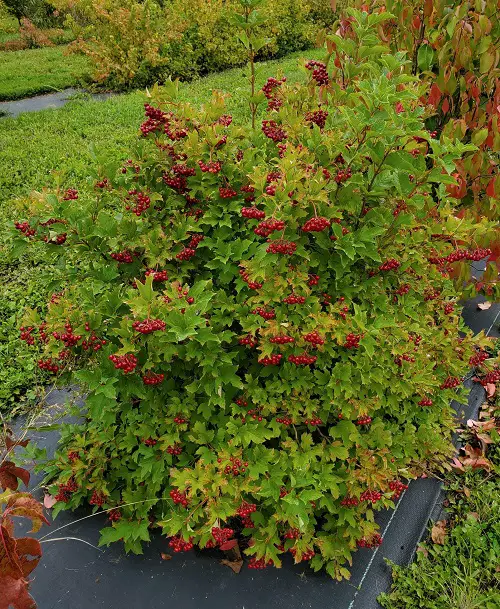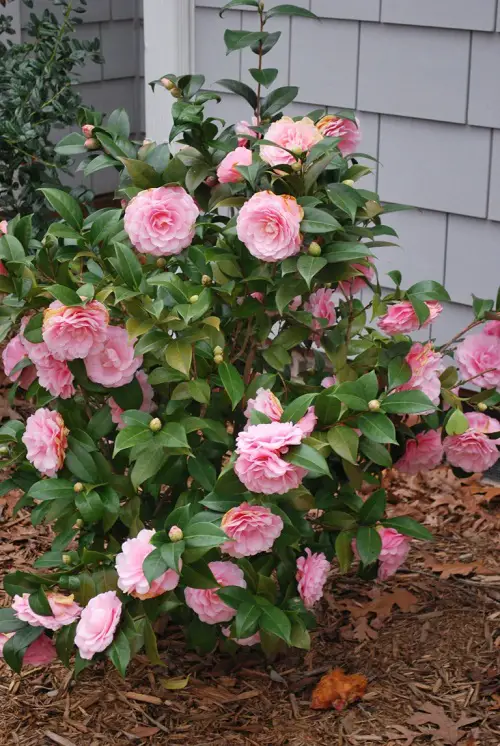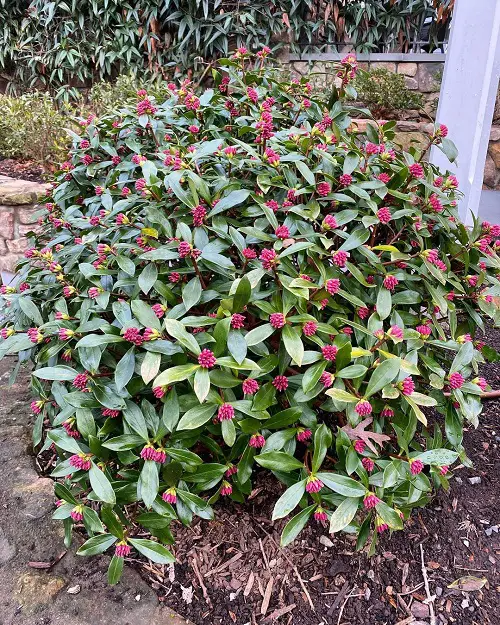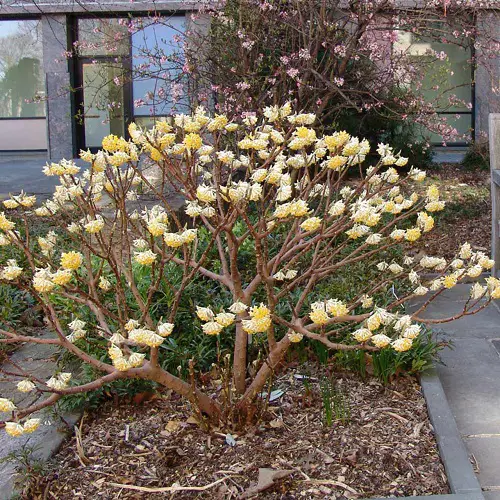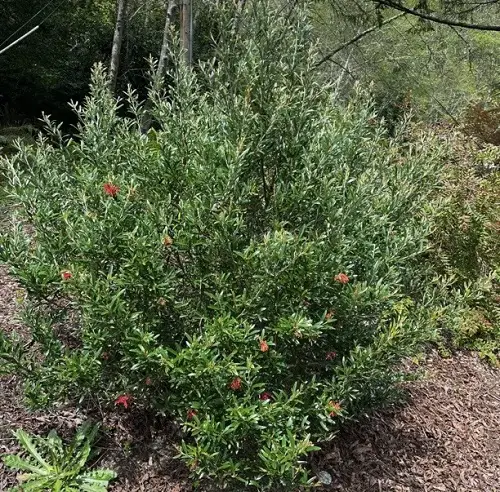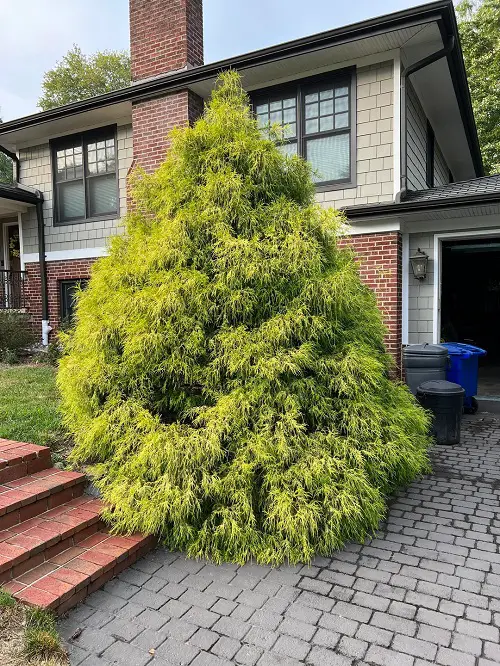Now that we’re well into fall, it’s time to plan for chilly weather! Here are the Best Shrubs to Plant for Winter Interest in the Garden.
Like sunny summers, mellow winters have their own special charm! And the time is ripe to give your garden a cool-season makeover. With colorful foliage, fragrant blooms, and luscious berries, here are the best shrubs to plant for winter interest!
Best Shrubs to Plant for Winter Interest in Garden
1. Blue Holly
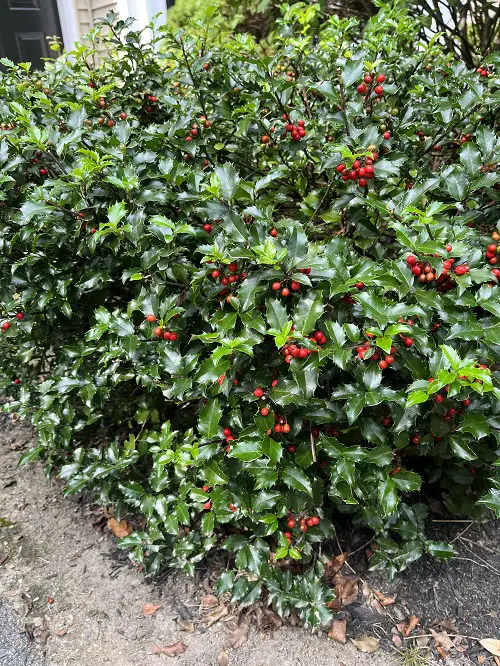
Botanical Name: Ilex x meserveae
USDA Zones: 5-7
Also known as Meserve holly, this is one of the hardier holly varieties that can thrive in various northern climates. This evergreen hybrid features spiny, blue-green foliage with a glossy texture alongside dark red berries—food for songbirds and bees but not humans!
When planted in well-draining soil, this shrub can grow up to 15 feet tall in full sun. An important key point to remember when growing Meserve holly for the berries, it needs pollination from a nearby male plant.
2. American Cranberry Bush
Botanical Name: Viburnum opulus var. americanum
USDA Zones: 2-7
Do not confuse this shrub with edible cranberries! Despite its similar appearance and name, the American cranberry bush is part of a different species. The red fruits of this deciduous shrub are a favorite of several types of birds, butterflies, and bees.
Growing up to 8-12 feet in height, the American cranberry shrub is adorned with beautiful white flowers and colorful foliage, even in spring and fall!
3. Japanese Camellia
Botanical Name: Camellia japonica
USDA Zones: 7-9
What better shrub to add to your garden than the Rose of Winter? This shrub showcases stunning blooms in white or pink, with hardy varieties that can withstand pretty nippy weather! Check out varieties like Snow Flurry, Polar Ice, and Winter’s Charm.
This shrub thrives in well-draining soil under partial shade and remains in controllable height of up to 6-12 feet tall.
4. Firethorn
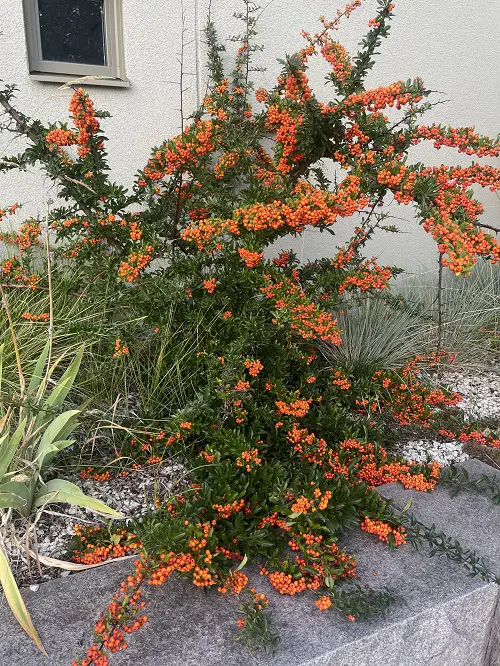
Botanical Name: Pyracantha coccinea
USDA Zones: 6-9
The firethorn shrub is one of the best evergreen to semi-evergreen choices for adding sunny, fiery hues in the peak of winter! It holds on to its sunny orange-red berries well into the cold. Plant it as a hedge against a wall or train it over a trellis—this one adapts!
The best cold-hardy varieties to look for are Mohave, Lalandei, and Yukon Belle.
5. Inkberry Holly
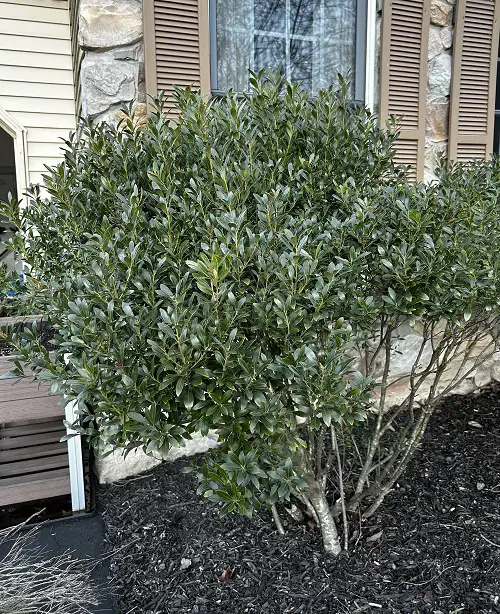
Botanical Name: Ilex glabra
USDA Zones: 5-10
The inkberry holly is known best for its cold hardiness and copious blackberries. Its blooms are a nectar source for bees, and beekeepers use them to make honey! This evergreen shrub, with its glossy foliage, is perfect for hedges.
When growing these 8-foot-tall shrubs, choose varieties like Compact and Shamrock and plant them in full sun or part shade. With a compact growth habit, this plant doesn’t need much pruning.
6. Sky Pencil Holly

Botanical Name: Ilex crenata
USDA Zones: 6-8
With tall, narrow growth that fits into tiny nooks and corners easily, the Sky Pencil holly cultivar is another favorite for adding vertical interest to the garden in winter. It is also easy to care for as a hedge and produces black, inedible berries in the fall.
Growing up to 10 feet tall and 8 feet wide, this compact shrub thrives in full to part sun, and moist, well-draining clay to loam soil.
7. Winterberry
Botanical Name: Ilex verticillata
USDA Zones: 3-9
Bright green leaves with clusters of tiny red berries popping out in a snowy landscape—what could lend more winter interest to your garden than the winterberry? This deciduous shrub can grow up to 12 feet tall, making it a perfect border plant.
It thrives in acidic soil in a spot with full sun or part shade. And if you love the sight of red berries, especially in the Christmas season, check out these frost-tolerant red-berried plants for containers.
8. Winter Daphne
Botanical Name: Daphne odora
USDA Zones: 7-9
Growing up to four feet wide and six feet tall, the sweetly fragrant pastel pink and lavender blooms of the winter Daphne are all it takes to snap you out of the winter blues. However, this evergreen shrub with variegated leaves is toxic to humans.
Plant this shrub as a hedge along a fence or wall, but ensure it’s away from human traffic. You can grow it close to a patio to enjoy the sweet fragrance of its flowers.
9. Paperbush
Botanical Name: Edgeworthia chrysantha
USDA Zones: 7-10
Want to experience spring in the dead of winter? Plant paperbush in your winter garden! The sweet, strong fragrance of its clusters of yellow and white blooms on the bare silhouette of the shrub is a treat for the senses!
This shrub grows up to six feet tall. Pick varieties like Gold Rush, Snow Cream, and John Bryant for your winter garden.
10. Red Twig Dogwood
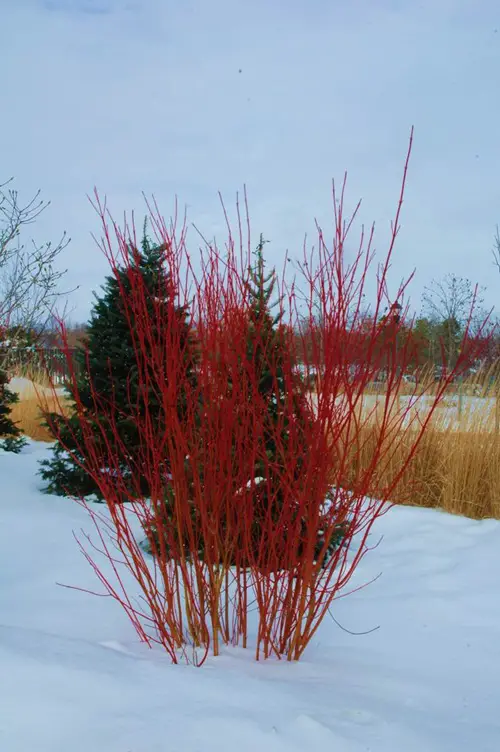
Botanical Name: Cornus sericea
USDA Zones: 3-7
As the name suggests, red twig dogwood is a vision in red on a snowy landscape! Native to most states of North America, this deciduous shrub showcases bright green bark and foliage in the spring, turning red or burgundy in the fall into winter.
Growing up to nine feet tall, you could plant this shrub alongside cultivars like the White Gold or Flaviramea. These feature yellow stems, hence the name—golden twig dogwood.
11. Harry Lauder’s Walking Stick

Botanical Name: Corylus avellana ‘Contorta’
USDA Zones: 4-8
Can we pause for a moment to pay respect to this incredible name? It’s no coincidence that the plant has spiraling, corkscrew-like branches that resemble a wizardly stick. While this deciduous shrub provides year-round interest, it truly stands out in bare winter.
Its unique architectural form is amplified by bright yellow catkins that hang from its 10-foot-tall stems in late winter!
12. Dwarf Arborvitae
Botanical Name: Thuja occidentalis
USDA Zones: 2-7
Perfect for foundation planting or growing as a hedge, the dwarf arborvitae also works well in containers, small gardens, and window boxes. For a stunning winter garden, go for the golden-leaved Filip’s Magic Moment or the soft, feathery Teddy cultivar.
13. Snowberry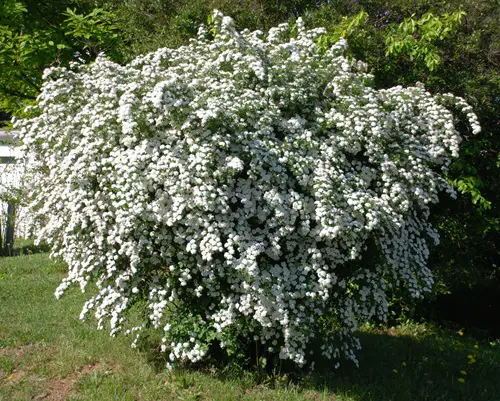
Botanical Name: Symphoricarpos albus
USDA Zones: 3-7
Native to the eastern part of North America, the snowberry is a must-have shrub to add winter interest to your landscape! Its fruit clusters go from green in summer to a snowy white in fall. And into winter, these snowy berries are all that remain on its bare branches!
If you have a sloping garden, snowberry can be the perfect plant to grow as its roots stabilize the soil. Note that its fruits are mildly toxic.
14. Red Chokeberry

Botanical Name: Aronia arbutifolia
USDA Zones: 4-9
Finally, we have an edible berry to add to our winter-interest shrubs! The small, tarty fruits of this native deciduous shrub have a glossy texture, ripening in late summer and lasting well into winter.
With the passing of spring, summer, and fall, its white blooms and color foliage make way for its pectin-filled berries used in jams and jellies. For year-round interest, go for the compact Brilliantissima variety. It gives more fruits and showcases brighter fall hues.
15. Sweet Box
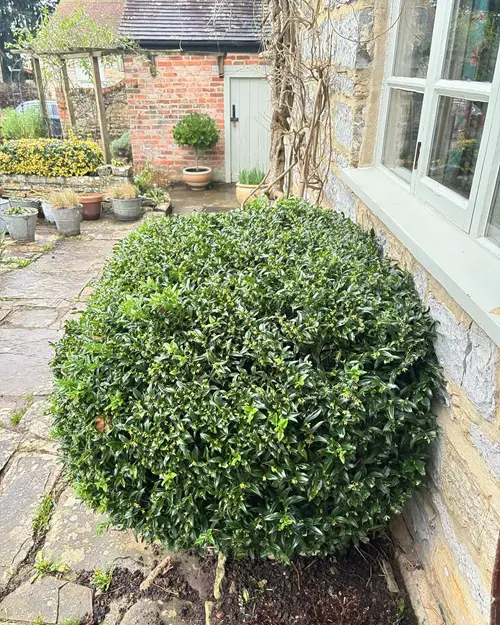
Botanical Name: Sarcococca confusa
USDA Zones: 6-9
There’s nothing like too many berries in a winter garden! Sweet Box is an evergreen shrub with fragrant white flowers and deep blue berries that are, of course, inedible to humans! A perfect addition to a shade garden, this shrub is a slow-grower with a compact habit.
Growing up to five feet tall and wide, this shrub is resistant to deer, rabbits, and pollution and thrives in different soil types, including dry mediums.
16. Boxleaf Azara
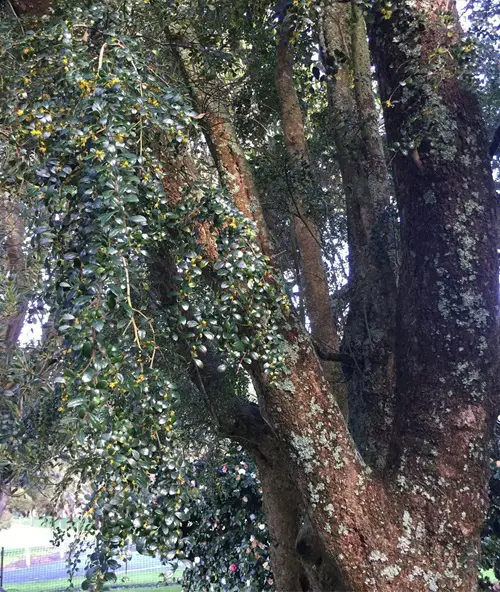
Botanical Name: Azara microphylla
USDA Zones: 8-10
More of a small tree than a shrub, this evergreen plant can reach up to 18 feet tall and 12 feet wide! All year round, you will find adorable round leaves sparkling in the sunlight. But the shrub’s highlight is its fragrant flowers that bloom in winter and smell like brownies!
17. Neil Bell
Botanical Name: Grevillea ‘Neil Bell’
USDA Zones: 9-11
If you have ample space in your garden, grow grevilleas in winter. This shrub has paddled-shaped evergreen foliage and produces red spidery winter blooms that attract hummingbirds to the garden.
Plant this shrub in full sun. It needs little care and does not mind poor soil quality.
18. Japanese False Cypress
Botanical Name: Chamaecyparis pisifera
USDA Zones: 4-8
Pick a false cypress variety like Golden Mop to add a sunny golden shimmer to your winter landscape. This low-growing shrub has a shaggy, mop-like appearance and soft needle or thread-like foliage.
Another variety to explore is the Dwarf Gold Thread, but remember that other cultivars of this species would give you a huge tree instead of a compact shrub! So, it’s best to know and plan according to the available space.
19. Boxwood

Botanical Name: Buxus spp.
USDA Zones: 3-7
Fond of topiary and evergreen shrubs? You cannot go wrong with boxwood! This classic architectural shrub is perfect for adding symmetry, filling out space, and lending any landscape a gorgeous green lushness in any season!
Though some varieties are only hardy till zones 5 and 6, most tolerate cold and are not prone to winter burn. Boxwood can easily grow up to eight feet, depending on the variety. And if you have trouble growing boxwood, check out these efficient alternatives!
20. Witch Hazel

Botanical Name: Hamamelis virginiana
USDA Zones: 3-8
Some of you may already know witch hazel for its ability to work as a makeup remover. But in your winter garden, it will outshine all with its beautiful fragrance! Plant it in full sun to thoroughly relish the delicate, thread-like petals of its winter blooms.
The flowers curl up during the night and unfurl again under the sun. Depending on the variety, they can be anywhere between white, yellow, and burgundy. At the same time that they bloom, through fall and winter, they also produce green to woody edible fruits.
For more flowers that bloom from fall through winter, check out this article!
Now, while winter berries look delicious, not all are edible. Make sure you check before you pop them in your mouth! And let us know via the comments below the shrubs you pick for your winter garden this year.


